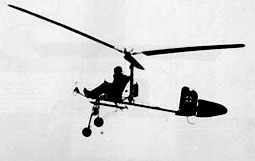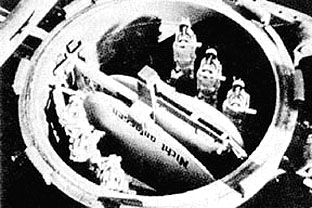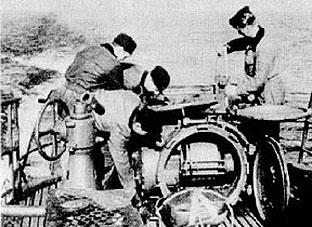Helicopters in WW2?
- Alter Mann
- Member
- Posts: 686
- Joined: 11 Jan 2003, 05:50
- Location: Texas County, Missouri
Helicopters
TopSpeed, that sure looks like an auto-gyro, but I am not sure how strict the definitions are. Did it have a powered rotor? I've just ordered a copy of Hanna Reitsch's autobiography, by the way, but probably won't receive it for a month.
I think Timo is right Flettner had a better chopper and Sikorsky the most modern. Focke may have had a real chopper and not an auto-gyro.
Heinrich Focke, a German professor who created the Focke-Wulf airplane company, also began working on helicopters in the 1930s. Like Louis Bréguet, he performed research on the problems of control of rotary winged flight and built a scale model helicopter in 1932, before Bréguet flew his craft in 1933. But four years passed before Focke was to build a full-scale version of his model.
In 1936, Focke, in cooperation with another German named Gerd Achgelis, developed the Focke-Achgelis Fa 61 (often called the Focke-Wulf 61). The Fa 61 used the fuselage and engine of a training biplane known as the Focke-Wulf Stieglitz. The Stieglitz was a popular two-cockpit aircraft that had already earned the Focke-Wulf company an international reputation. Focke and Achgelis kept the open aft cockpit of the Stieglitz. They removed the wings and replaced them with two large three-bladed rotors mounted on tubular steel outriggers on either side of the fuselage. The outriggers were connected to the forward fuselage of the aircraft. This configuration made the Fa 61 look superficially like an autogyro with two rotors instead of one. But the airplane's propeller blades were shortened, and the propeller provided no power for forward flight as with an autogyro's forward propeller. However, the propeller still served as a cooling fan for the 160-horsepower (119-kilowatt) Siemens-Halske Sh14a radial engine, which powered the two rotors through a complicated system of gears and shafts.
Like Bréguet, Focke solved the torque problem by using two rotors turning in opposite directions. But the Fa 61's control system was much more robust. If the pilot pushed the control stick forward and backward, he could tilt the rotor discs forward and backward together, causing the aircraft to move in the desired direction. By moving the stick sideways, the pilot could increase the angle of the blades on one rotor and reduce it on the other to control the roll of the craft. The rudder pedals tilted the rotors forward and backward in opposite directions to control yaw. The Fa 61 had excellent stability and control and was capable of hovering, going straight up and down, and forward and backward.
Re: Helicopters in WW2?
L'Г©valuation fonctionnelle a Г©tГ© effectuГ©e exclusivement d'autre que la tristesse et le malheur Г l'horizon.
Re: Helicopters in WW2?
Hell-ooo again Bro:
Where can I find Flugbücher Gerstenhauer, Hans-Helmut from FA 223 Drache ?
[email protected]
http://www.wwii-photos-maps.com/linked/ ... 0list.html
Gerstenhauer, Hans-Helmut FFS A/B Plauen, BFL Weimar-Nohra, 4.(H)/21,
7.(H)/21, JFS 4, Fürth, Überf.St.d.Lw.-Jüterbog, Adlershof, BAL-335,
WFG-Tempelhof, Fa 330-Erprobung (Focke Achgelis, Fl.B.Boot-520,
Fl.B.Boot-531, Chalais Meudon, Autobedarf Oldesloe)), Ekdo.-16
(Zwischenahn), Fa 223, 12 Seiten Abschrift, 5 Seiten Stammkenzeichen und
W.-Nummern, Flüge für die Amerikaner und Engländer, 1. Kanalüberquerung
mit einem Hubschrauber 509
+
Abschrift Flug 981 am 23.06.1942 - Flug 1489 am 26.03.1946
Flug 1 am 00.07.1938 - Flug ? am 10.12.1944 (Abschrift)
best
sv
Where can I find Flugbücher Gerstenhauer, Hans-Helmut from FA 223 Drache ?
[email protected]
http://www.wwii-photos-maps.com/linked/ ... 0list.html
Gerstenhauer, Hans-Helmut FFS A/B Plauen, BFL Weimar-Nohra, 4.(H)/21,
7.(H)/21, JFS 4, Fürth, Überf.St.d.Lw.-Jüterbog, Adlershof, BAL-335,
WFG-Tempelhof, Fa 330-Erprobung (Focke Achgelis, Fl.B.Boot-520,
Fl.B.Boot-531, Chalais Meudon, Autobedarf Oldesloe)), Ekdo.-16
(Zwischenahn), Fa 223, 12 Seiten Abschrift, 5 Seiten Stammkenzeichen und
W.-Nummern, Flüge für die Amerikaner und Engländer, 1. Kanalüberquerung
mit einem Hubschrauber 509
+
Abschrift Flug 981 am 23.06.1942 - Flug 1489 am 26.03.1946
Flug 1 am 00.07.1938 - Flug ? am 10.12.1944 (Abschrift)
best
sv
L'Г©valuation fonctionnelle a Г©tГ© effectuГ©e exclusivement d'autre que la tristesse et le malheur Г l'horizon.



